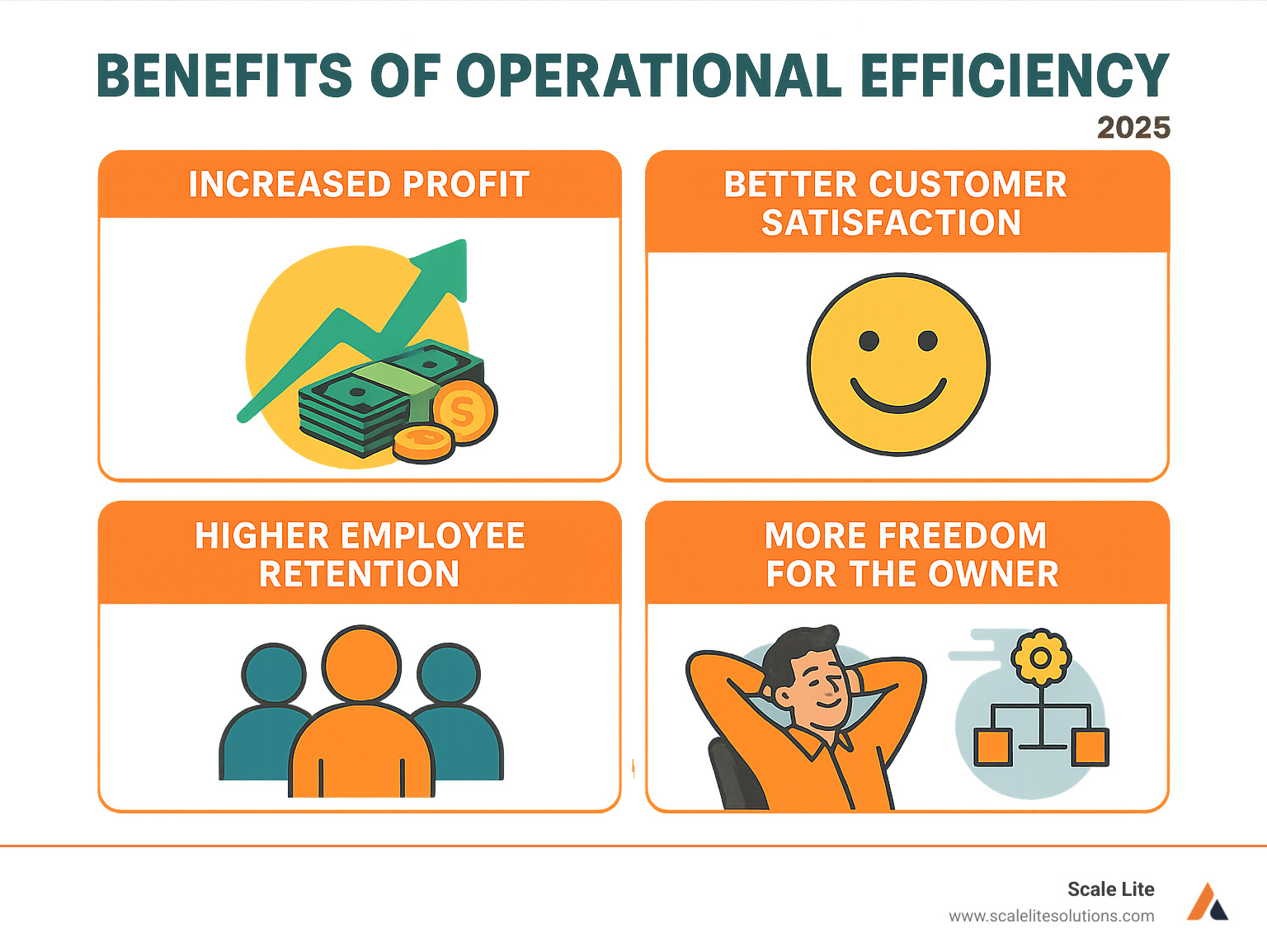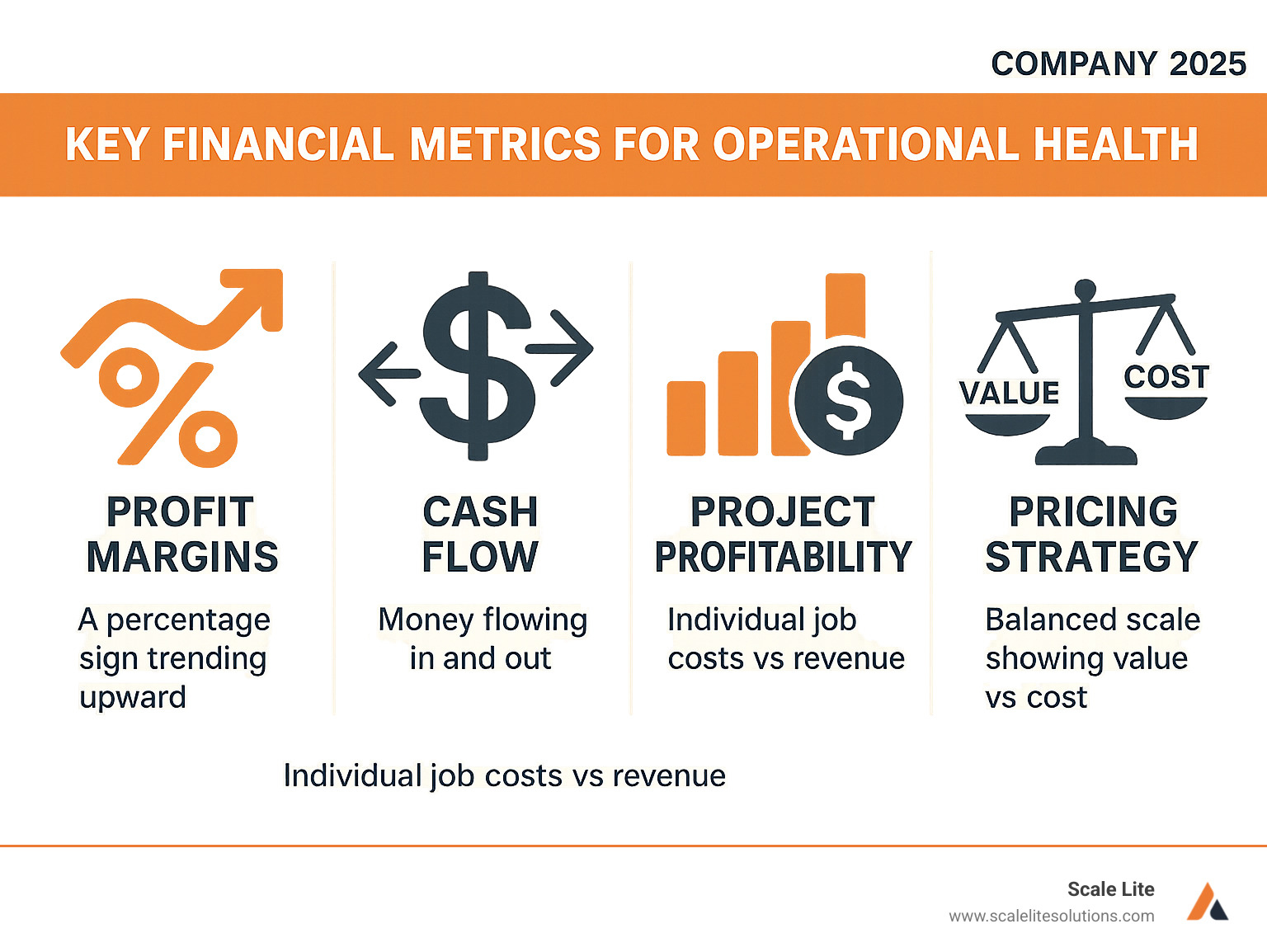
How to Improve Business Operations Without Breaking a Sweat

Why Smart Business Operations Are Your Secret Weapon
Improve business operations and you'll open up more profit, less stress, and the freedom to focus on what matters most. Here's what effective operational improvements deliver:
Quick Wins:
- Reduce waste - Cut time spent on repetitive tasks by 30-50%
- Boost profits - Increase customer retention by 5% to see 25-95% profit growth
- Free up your time - Move from working in your business to working on it
- Improve quality - Standardize processes to deliver consistent results
- Retain staff - Clear systems reduce employee frustration and turnover
The numbers tell a sobering story. The average UK office worker is productive for only 2 hours and 53 minutes each working day. More than 40% of workers are considering leaving their jobs within the next year. Poor communication alone causes 28% of employees to miss deadlines.
But here's the good news: these problems are fixable.
When you streamline operations, you're not just making things run smoother - you're building a business that works without you constantly putting out fires. You're creating systems that let your team succeed, your customers stay happy, and your profits grow predictably.
The best part? You don't need to overhaul everything at once or spend a fortune on fancy software. Small, smart changes compound into big results.
I'm Keaton Kay, and I've spent years helping business owners improve business operations through my work in private equity, enterprise sales, and now as founder of Scale Lite. I've seen how the right operational changes can transform a chaotic, owner-dependent business into a valuable, scalable asset.

Basic improve business operations terms:
First, See Where You Stand: Auditing Your Current Operations

You wouldn't drive across the country without knowing where you're starting from, right? The same goes for trying to improve business operations - you need to understand what's actually happening in your business before you can fix what's broken.
Think of this as getting a health check-up for your company. You can't treat symptoms you don't know exist, and you might be surprised by what you find when you really dig in.
Start by becoming a detective in your own business. The most effective way to audit your operations is to go "undercover boss" in your own company. Put down the phone, step away from the emails, and actually watch what happens on the ground level.
Map out your key processes by writing down every single step in your most important workflows. How do you handle customer inquiries? What happens from the moment someone calls until the job is complete? Don't assume you know what's happening - actually observe and document the real process, not what you think should be happening.
Your employees are walking goldmines of operational insight. Talk to your team and create a safe space for honest feedback. They know exactly where the bottlenecks are, which steps feel pointless, and what tools would make their jobs easier. Often, the people doing the work daily have the best ideas for improvement.
Track your numbers consistently by identifying your Key Performance Indicators and measuring them religiously. This includes tracking time from customer inquiry to job completion, measuring customer satisfaction scores, monitoring employee productivity, analyzing profit margins per job, and watching customer retention rates.
Here's something most business owners overlook: customer complaints are free consulting advice. They'll tell you exactly where your operations are failing from the perspective that matters most. Keep a simple log of common issues and how often they happen.
Follow the money trail by analyzing where you're spending time and resources versus where you're actually making profit. You might find that 20% of your activities generate 80% of your results - and you're spending way too much time on the wrong 80%.
The key is approaching this audit without judgment. You're not looking to blame anyone or beat yourself up about what's not working. You're simply trying to understand reality so you can make it better.
As Nicole Tiefensee, COO and co-founder of Runn, puts it: "Operational efficiency is about achieving more with less. Getting more output with the same input." That's exactly what we're after.
Once you have a clear picture of your current state, you can start making targeted improvements that actually move the needle. Our Data-Driven Business Strategy resource can help you structure this analysis in a way that leads to real results.
7 Smart Strategies to Improve Business Operations
A Simple Guide to Improve Business Operations Through Process Review
Think of your processes like recipes. If the steps are only in someone’s head, one sick day can create chaos. Start by writing simple Standard Operating Procedures (SOPs) for every critical task. Then ask of each step: “If we skipped this, would quality drop?” Remove anything that fails the test, break complex jobs into smaller pieces, and use short checklists to keep work consistent. Our Business Process Streamlining guide walks you through the details.
Leverage Technology and Automation (The Right Way)

Automate tedious, repeat-able work first—sending invoices, appointment reminders, or inventory alerts. A well-chosen Customer Relationship Management (CRM) tool keeps every customer detail in one place so nothing slips through the cracks. McKinsey research shows tidier data alone can trim 5–15 % in wasted spend. Start small, master one workflow, then expand. As Ella Steinmetz-Simon, COO at 14Minds, notes, “Every penny you put into the right automation pays you back.” Find easy starters in our AI-Driven Workflow Automation and Digital Change Examples for Small Business.
Empower Your People and Build a Winning Culture
Poor communication is behind 28 % of missed deadlines. Fix it with short daily huddles, clear roles, and simple channels. Invest in training—untrained staff work slower and leave sooner. Give employees autonomy and recognize good work; people with control over their day are twice as productive. Burnout is now the top reason people quit, according to Inc. Keep workloads realistic and hire carefully; a bad hire can cost over $240,000.
Focus Intently on Your Customers
Happy customers cost less to keep and buy more often. Make service your edge by turning feedback into action. Bain found that a 5 % boost in retention raises profit 25-95 %. Track response time, on-time completion, and Net Promoter Score (NPS). Our Scalable Service Operations guide shows how.
Get Smart with Your Finances

Price for profit, not just parity with competitors. Track profitability by job so you can double down on winners and fix or drop losers. Active cash-flow management—quick invoicing, firm follow-ups—keeps growth plans funded. For more, see How to Price Your Products.
How to Improve Business Operations with Data-Driven Decisions

Measure what matters—think revenue per employee, average job time, and customer satisfaction. Display these numbers on a simple dashboard so everyone sees progress in real time. Test changes, keep what works, drop what doesn’t. Our Data-Driven Decision Making resource keeps it straightforward.
Make Continuous Improvement a Habit
Great operations are never “done.” Schedule monthly or quarterly reviews, watch industry trends, and invite employee suggestions. Set fresh targets as soon as you hit the old ones. When something flops, capture the lesson and move on. For a structure you can copy, see How to Achieve Operational Excellence.
Each of these seven strategies is simple, but together they compound—cutting waste, delighting customers, and freeing you to grow.
Frequently Asked Questions about Improving Business Operations
What's the difference between being busy and being efficient?
Here's the truth that most business owners find the hard way: being busy and being efficient are completely different things. You can work 12-hour days and still feel like you're getting nowhere.
Being busy means your calendar is packed and you're constantly putting out fires. Being efficient means you're focusing on activities that actually move your business forward. It's the difference between running on a hamster wheel and running toward a finish line.
I see this all the time with business owners who tell me they're "too busy" to improve business operations. They're answering emails all day, jumping between tasks, and handling every small crisis personally. They feel productive because they're exhausted, but their revenue and profits aren't growing.
Efficiency focuses on outcomes, not just activity. It asks: "Will this task directly help my customers or increase my profits?" If the answer is no, it's probably just busy work.
The shift happens when you start measuring results instead of hours worked. Are you completing more profitable jobs? Are customers happier? Is your team more productive? These outcomes matter more than how many emails you answered.
Where should I start if I have a limited budget?
Good news: the most powerful operational improvements often cost nothing but time and attention. I've seen businesses save thousands of dollars and dozens of hours per week without spending a penny on new software or equipment.
Start with what you already have. Document your current processes exactly as they happen - not as you think they should happen. This simple exercise reveals inefficiencies that have been hiding in plain sight. One client finded they were entering the same customer information into three different systems because nobody had mapped out the actual workflow.
Communication improvements are free but incredibly valuable. Most operational headaches stem from people not knowing what's expected, when it's due, or who's responsible. Create regular check-ins with your team, clarify roles and responsibilities, and establish clear communication channels.
Your customers will tell you exactly what to fix for free. Ask them what's working and what isn't. Their feedback often points directly to the operational changes that will have the biggest impact on your business.
Pick one small problem and solve it completely before moving to the next one. Maybe it's the scheduling system that causes confusion, or the invoicing process that delays payments. Small wins build momentum and prove that improvement is possible.
Remember: the most expensive operational problems are often the ones you're ignoring. A few hours spent fixing a recurring issue can save you months of frustration and lost revenue.
How do I get my team on board with operational changes?
Change is hard for everyone, and your team has probably seen "improvement initiatives" come and go before. The key is making them partners in the solution, not victims of your latest idea.
Start by explaining the why behind the changes. People resist what they don't understand, but they support what makes sense to them. Will this new process make their jobs easier? Reduce the frustration they feel every day? Help them serve customers better? When people see how changes benefit them personally, resistance usually melts away.
Involve your team in designing the solutions. They're closest to the actual work and often have the best ideas for improvement. Ask questions like: "What part of this process drives you crazy?" or "If you could change one thing about how we do this, what would it be?" When people help create the solution, they own it.
Provide the support they need to succeed. Don't expect people to adapt to new processes without help. Offer training, create simple guides, and be patient as they learn. Most importantly, be available to answer questions and solve problems as they come up.
Celebrate the wins together. When improvements work, make sure everyone knows about it. Share the results - time saved, customers happier, work flowing more smoothly. This reinforces that change is good and builds momentum for future improvements.
Start small and build confidence. Big changes feel overwhelming and scary. Begin with simple improvements that are easy to implement and show quick results. Success builds trust and makes people more open to bigger changes later.
Your team wants to succeed just as much as you do. When you frame operational improvements as ways to help them do their best work, you'll be surprised how many great ideas and how much support you get.
Conclusion: From Chaos to a Business That Runs Itself
Think of improving business operations like tending a garden - you don't plant seeds and expect a harvest overnight, but with consistent care and attention, small efforts bloom into something beautiful.
Every business owner I've worked with starts in roughly the same place: feeling overwhelmed by daily chaos, constantly putting out fires, and wondering why they can't seem to get ahead despite working harder than ever. The good news? This frustration is actually the first sign that you're ready to build something better.
Your journey from chaos to clarity follows a simple path: Start by honestly auditing where you stand today - not where you think you should be, but where you actually are. Then strategize by picking the improvements that will give you the biggest bang for your buck. Implement these changes one at a time, starting with the quick wins that build momentum. Measure your results so you know what's working and what needs tweaking. Finally, make continuous improvement part of your company's DNA.
The real magic happens when you stop trying to be the hero of every story in your business. When your operations run smoothly, you're no longer the bottleneck - you become the visionary who can focus on growth, innovation, and actually enjoying business ownership again.
At Scale Lite Solutions, we've watched countless blue-collar service businesses and companies in low-tech industries make this change. Our holistic approach focuses on creating sustainable systems through strategic technology deployment, workflow automation, and CRM optimization. We help business owners build companies that drive enterprise value while giving them their lives back.
Here's what I've learned after years of helping businesses improve their operations: the companies that thrive aren't necessarily the ones with the most money or the biggest teams. They're the ones with the smartest systems. They've figured out how to work smarter, not harder, and they've built operations that scale with their dreams instead of limiting them.
Your business absolutely can run itself - but only if you're willing to build the systems that make it possible. The path from overwhelmed owner to Hands-Off Business Owner starts with a single small improvement today.
Ready to stop being the bottleneck in your own success story? Explore our Trades Business Growth Strategies to build a more profitable, efficient, and valuable company.
For deeper insights on creating operations that work without constant supervision, check out our resource on Businesses That Run Themselves.
The change from chaos to clarity isn't just possible - it's inevitable when you commit to the process. Your future self will thank you for taking that first step today.






